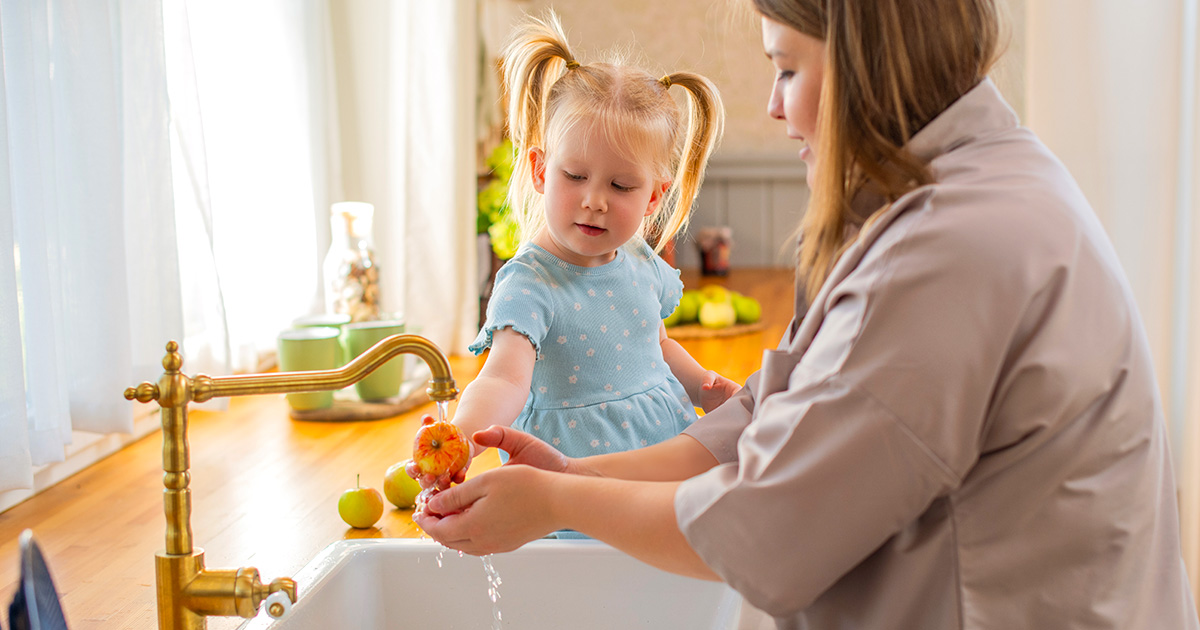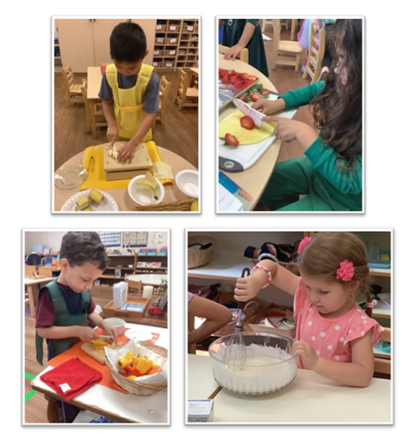- 855.471.2589
- Schedule a Tour

Practical Life is the heart of the Montessori classroom. The goal is to support each child’s journey to develop independence, confidence, and lifelong skills. With some intentional effort, this approach can also benefit their growth at home.
The Practical Life area at school contains many attractively displayed objects familiar to the child, including a variety of items commonly used in daily living tasks for eating, dressing, and cleaning. At school, this is the area where most children begin working independently. The materials are carefully designed to help teach skills involved with caring for themselves and the classroom environment.
“The first aim of the Prepared Environment is, as far as it is possible, to render the growing child independent of the adult.”
Dr. Maria Montessori, The Secret of Childhood, p. 267
Dr. Montessori noted that the purpose of a child’s work is to create the adult he or she will become. Each little task, especially when well-chosen, contributes to his or her development. The child’s interest comes from the desire to imitate the important people in their life, including parents, older siblings, teachers, and a community of peers. When we hear “Let me do it,” it is an invitation to let the child work alongside us, especially in the kitchen! This space is a true sensory haven for children with wonderful things to smell, taste, and feel.
At school, food preparation involves activities and lessons that build upon each other until the child can independently pour a glass of water and clean up any spills; peel a carrot or slice an apple for a snack; set the table for lunch, clear the table, and wash their dishes. Young children want to work on the real-life tasks they see every day at home to support their classroom community.
At home, inviting your child to spend time with you in the kitchen is the easy part. They want to be with you! Being prepared helps ease the stress of the potential mishaps and messes. Remember these tips to set yourselves up for success:
- Dedicate a drawer where your child may keep child-sized cutlery, plates, bowls, cups, a pitcher, and placemats that show proper placement of the plate, cup, and cutlery.
- If space allows, set up a short table to create a counter-like workspace for your child. Or consider providing a sturdy stool to elevate them to the height of your countertop.
- Offer opportunities to allow as much independence as possible to send the message that they are capable. Consider placing a stool by all sinks and providing a basket of towels and a small spray bottle of water so that they may clean up their area or spills.
Take a moment to reflect on all the little things you need to do to create a meal or follow a recipe. Tasks you might find mundane are new, exciting, necessary skills to develop, and most importantly, fun for your child. Really! Greasing a pan can be fun. Forget the spray and let your child spread oil or butter all over the bottom of the baking dish. Instruct on how every corner needs to be covered. Add a little science here while you wash your hands using warm water and soap to get the oil off by discussing the barrier that the fats will provide to keep the baked good from sticking to the pan. It’s enjoyable and informative!
Washing/Scrubbing
The simplest skill, and one even a young toddler can do, is to help wash vegetables and fruit. Place a basin of warm water on a short table or the floor. This can also be done at the sink if you have a step stool. Give your child a brush to gently scrub the skin of the fruit or vegetable, a paper towel or dish towel to dry it, and another bowl or a clean spot to set the washed produce. Work from left to right to build pre-reading habits!
Peeling
Peeling is a great task to build hand strength and fine motor control. Try starting with items such as hard-boiled eggs, bananas, or oranges. If necessary, you can start the peeling process for them; however, if you do roll the egg on a plate and apply a little pressure to crack the shell, talk them through that process. Or if opening a banana, be sure the child can see your hands as you pinch the end. Peeling oranges can be tricky, so if you use a tool, show your child how it’s done. Use your best judgment based on your knowledge of the tool and your child’s development to determine if they’re ready to safely try it.
Using a vegetable peeler can be another fun task for older children. Minimize risks by instructing your child on the proper way to hold the vegetable near their body and how to use the tool. Guiding them to peel away from their body with firm, even motions will help with fine and gross motor development. To prevent nicks, you can have your child hold the vegetable in place with a thin, clean dish towel.
Slicing/Cutting/Chopping
Slicing soft objects using either a blunt knife or a specific cutting tool is another great activity and encourages children to eat what they are cutting. Use a crinkle cutter to slice through a peeled cucumber, an apple slicer to cut an apple, or a butter knife to slice a banana or avocado. Participation in making a recipe to serve the family will give them a sense of pride. Another benefit is that it may entice them to taste something new.
Measuring
Measuring dry ingredients can be messy, but it is an activity that develops concentration. A helpful tip is to use a smaller measuring size and fill it more times. It’ll make the work for small hands easier to manage. Demonstrate how to level the scoop with a board scraper or butter knife. This activity also provides a simple opportunity for counting and a transition into talking about fractions. Again, breathe through what might be a messy endeavor. Children only learn by practice and repetition.
While working together in the kitchen is a perfect time to sneak in all types of “academics,” the experience and time together matter a great deal, too. The connections you are forging and the trust you are building with your child are just as important as the skills they might learn, including vocabulary, counting, measuring, fractions, cultural and historical exploration, and, of course, science. Focus on enjoying the process and do not worry too much about the product.
Need a few more Ideas for your little sous chef?
- Decorate cookies
- Fold napkins
- Spread peanut butter on celery
- Set the table
- Cut and arrange flowers in a vase
- Beat eggs
- Make meatballs (or sugar cookie balls)
- Scrape and wash dishes

